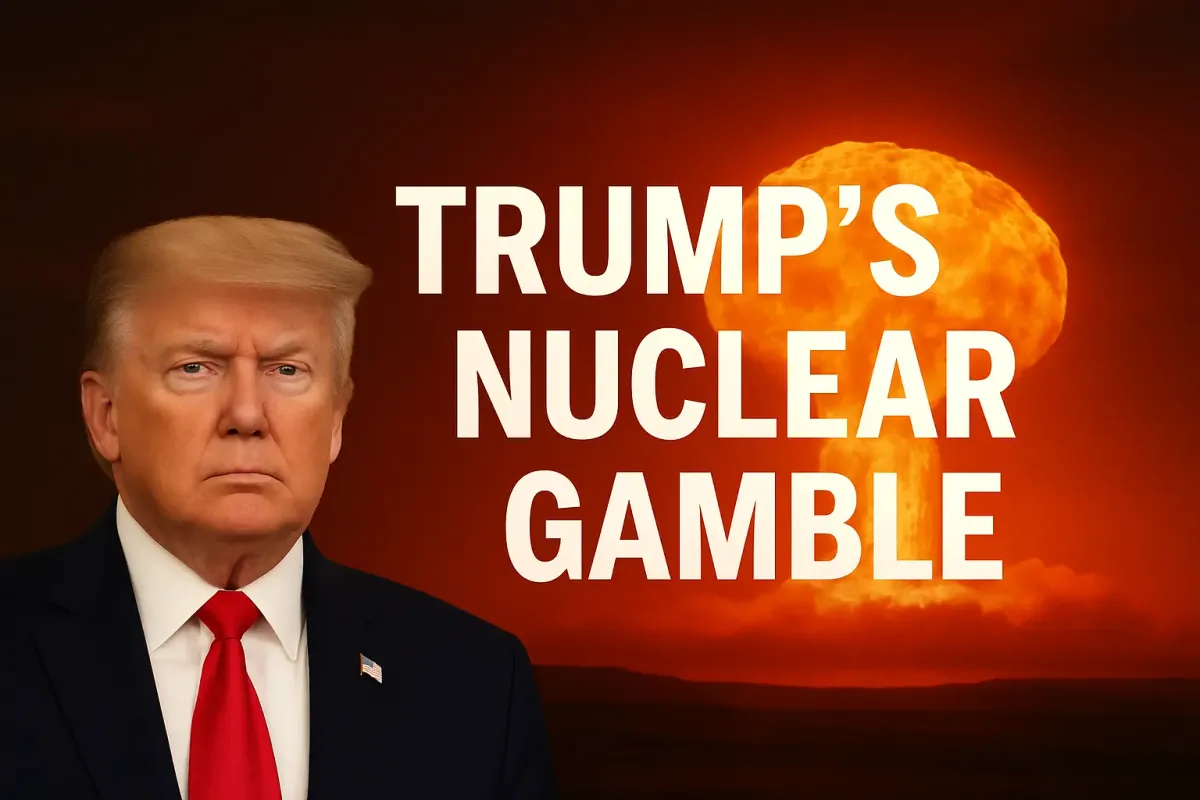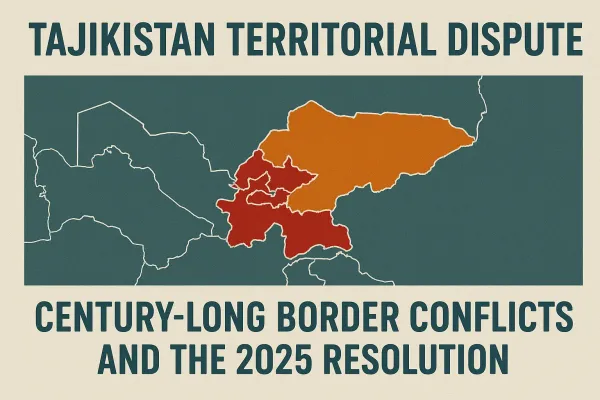From Restraint to Recklessness: How One Decision Could Rewrite Nuclear Power Dynamics Forever
Trump's nuclear testing breaks a 33-year global commitment. His announcement before meeting China's Xi marks a historic shift. While America claims strategic parity with rivals, experts warn it could trigger a worldwide nuclear testing rush—opposite of its intended goal.

President Donald Trump's decision to restart nuclear weapons testing has created genuine alarm around the world. His announcement, made through social media just before meeting Chinese President Xi Jinping in late October 2025, represents a historic break from three decades of restraint. Trump declared that the United States would begin testing nuclear weapons "on an equal footing" with other nations. This move raises serious questions about global security, international agreements, and whether the world is about to enter a dangerous new phase of nuclear competition.
Understanding the Historical Context
To grasp why Trump's announcement matters so much, you need to understand the history of nuclear testing and what the United States gave up. Between 1945 and 1992, America conducted over 1,000 nuclear detonations—more than any other country in the world. These explosions had devastating consequences. Radioactive material spread across the atmosphere, groundwater became contaminated, and communities across Nevada and the South Pacific suffered serious health problems. Entire regions became too dangerous to inhabit.
The Cuban Missile Crisis of 1962 showed humanity how close it had come to nuclear catastrophe. Following that terrifying moment, President Kennedy pushed for the Partial Nuclear Test Ban Treaty in 1963, which allowed underground testing but banned explosions in the atmosphere and underwater. Then in 1992, President George H.W. Bush made a bold decision. He announced a comprehensive moratorium on all nuclear testing—a decision that would hold for more than three decades.
Since 1996, the Comprehensive Nuclear Test Ban Treaty has represented the world's shared commitment to stopping nuclear explosions. Today, 187 countries have signed this agreement, showing global consensus that testing must end. While the United States, Russia, and China never officially ratified the treaty, they all followed its rules. Notably, North Korea broke this pattern—it conducted nuclear tests as recently as 2017, making it the only country in the modern era to do so.
Why Trump Decided to Resume Testing
Trump's reasoning centers on what he sees as unfair advantages given to other nations. In his CBS "60 Minutes" interview, he explained his thinking bluntly: "We're the only country that doesn't test, and I don't want to be the only country that doesn't test." He pointed to Russia, China, North Korea, and Pakistan as countries actively testing their weapons, claiming America was falling behind despite having what he describes as the world's largest nuclear arsenal—enough firepower to "blow up the world 150 times."
The announcement seemed triggered by Russia's recent test of the Burevestnik cruise missile, a nuclear-powered system that travelled 7,800 miles and demonstrated new capabilities that could expose gaps in American air defence systems. Trump's decision to announce this just minutes before his meeting with Xi Jinping suggests a calculated move—sending a message to Putin while simultaneously testing how Beijing would respond.
The Confusion Around What Trump Actually Means
One major source of confusion surrounds exactly what type of testing Trump intends to authorize. This distinction matters enormously. There's a huge difference between testing actual nuclear warheads by detonating them and simply testing the delivery systems and components of nuclear weapons. These represent completely different scenarios with wildly different consequences.
Energy Secretary Chris Wright tried to clear things up. He said the planned tests would be "systems tests" involving "noncritical explosions" that examine weapon components without producing nuclear detonations. According to Wright, nobody should expect to see mushroom clouds over Nevada.
However, Trump himself created confusion by answering directly when asked if the U.S. planned to detonate nuclear weapons. His response was unambiguous: "We're going to test nuclear weapons like other countries do, yes." This contradicts the administration's technical explanations, leaving nuclear experts genuinely uncertain about the president's real intentions.
Several respected experts offer interpretations that might bridge this gap. George Perkovich at the Carnegie Endowment for International Peace suggests Trump may be talking about subcritical tests—controlled laboratory experiments that refine triggering mechanisms using computer simulations rather than actual explosions. Siegfried Hecker, the former director of Los Alamos National Laboratory, notes that Russia, China, and the United States all conduct such experiments regularly, along with hydro nuclear tests that produce minimal explosive yield too small to register on earthquake monitoring equipment. These tests create small nuclear reactions without the dangers of mushroom clouds, environmental damage, or radiation release.
The Real Strategic Consequences
If Trump follows through with actual nuclear testing, the global implications could be enormous. Nuclear security specialists warn that restarting American tests would likely spark a worldwide rush to conduct tests, fundamentally destabilizing the international non-proliferation system that has prevented nuclear spread for decades. The United States actually holds a significant knowledge advantage here. Through its 1,000-plus historical tests, America accumulated more detailed information about nuclear weapons than any other nation, information preserved in computer databases and the expertise of its national laboratories.
If the testing moratorium breaks, China would benefit most substantially. China has conducted only 47 nuclear tests compared to America's 1,054 and Russia's 715. Chinese military planners have long felt hamstrung by arms control agreements that locked in this disadvantage. Heather Williams from the Center for Strategic and International Studies warns that if testing resumes globally, China would gain crucial knowledge about weapons design and warhead technology, accelerating its already rapid nuclear expansion. This creates a strange paradox: American testing supposedly meant to maintain superiority could actually help the competitor it's trying to contain.
→ Read Next: Tariff Shock 2.0: Why US–China Controls Are Repricing the World Economy
US–China tariffs and export controls are repricing the world—raising costs, constraining chips and minerals, and pushing supply chains to de‑risk. What it means for inflation, tech access, and strategy.
Does America Actually Need to Test?
This question gets to the heart of the debate. Does the United States really require nuclear testing for genuine technical reasons? The answer from America's scientific and defence communities has consistently been no. Every year since 1992, the directors of national nuclear laboratories have officially certified that the U.S. nuclear stockpile remains safe, reliable, and effective without conducting live tests. Scientists maintain the nuclear arsenal using vast amounts of historical data and powerful computer models derived from those previous tests. They can update designs and confirm reliability without causing radioactive contamination or creating environmental disasters.
Brandon Williams, who serves as under secretary of energy for nuclear security starting in 2025, told Congress that the Stockpile Stewardship Program successfully maintains reliability without explosive testing. Jeffrey Lewis, a leading nuclear policy expert, makes an important observation: "the United States understands how nuclear weapons work much better today than it ever did when it was conducting nuclear explosions." America's real advantage comes from accumulated knowledge and advanced computing power—advantages that explosive testing could actually diminish by giving competitors valuable learning opportunities.
Instead of explosive testing, nuclear professionals suggest other approaches to demonstrate American strength. The Department of Defence regularly conducts test launches of missiles like the Minuteman III intercontinental ballistic missile at Vandenberg Space Force Base. These visible demonstrations show operational readiness and capability without violating international standards, creating radiological hazards, or giving China learning opportunities that would accelerate its nuclear program.
Political Background and Planning
Trump's announcement represents a striking reversal from official policy until late October 2025. His first administration's 2018 Nuclear Posture Review stated it would not seek Senate approval of the Comprehensive Nuclear Test Ban Treaty but would continue supporting the treaty organization and its monitoring systems. The Biden administration took a similar approach, backing the CTBT and continuing the global testing halt without pursuing formal ratification.
This shift appears connected to Project 2025, the Heritage Foundation's detailed plan for restructuring federal government. That document specifically called for the president to "indicate a willingness to conduct nuclear tests in response to adversary nuclear developments if necessary" and order the National Nuclear Security Administration to achieve test readiness rapidly for "maximum flexibility in responding to adversary actions." Former Trump administration officials, including National Security Advisor Robert O'Brien, have publicly advocated for testing to "maintain technical and numerical superiority to the combined Chinese and Russian nuclear stockpiles."
The Practical Obstacles to Implementation
Turning presidential announcements into actual reality faces major institutional challenges. The Department of Energy and Department of Defence have not yet explained how testing would actually proceed. Secretary Wright announced staff furloughs at the National Nuclear Security Administration in October because of government shutdowns and budget restrictions—not exactly the ideal conditions for launching a complex and resource-intensive testing program. The national laboratories that would need to conduct this work currently operate with reduced funding, creating real questions about how quickly or efficiently tests could begin.
Moreover, conducting explosive tests at the Nevada Test Site involves substantial preparation requirements. Safety protocols, environmental impact assessments, and regulatory reviews could take years to complete. The infrastructure, personnel expertise, and regulatory systems that supported the pre-1992 testing program have deteriorated over thirty years of non-use. Building them back up presents formidable practical obstacles to rapid implementation.
Threatening the Global Non-Proliferation System
Trump's decision threatens to unravel decades of carefully constructed international non-proliferation agreements. The global norm against testing serves as a cornerstone supporting broader efforts to prevent nuclear weapons spread. When the world's most powerful nuclear state breaks this standard, it sends dangerous signals through the international system. Other nations seeking nuclear weapons get a compelling rationale: if the superpower is testing, why shouldn't we?
The move also undermines American credibility when criticizing nuclear programs elsewhere. How can Washington object to Iranian or North Korean nuclear ambitions while simultaneously ending its own testing moratorium? The logic Trump's decision establishes allows any nation to justify testing by pointing to competitors' programs. This creates a race-to-the-bottom dynamic that gradually erodes the collective security framework.
→ Explore Related Analysis: From Allies to Adversaries: How the Taliban–Pakistan Relationship Broke Down and What It Means for South Asia
Pakistan’s decades-long gamble of nurturing militants for influence in Afghanistan has collapsed. The Taliban’s rise has turned into Islamabad’s nightmare, with cross-border attacks, diplomatic strain, and growing regional isolation.
The Crucial Question About the Future
Trump's announcement raises a fundamental question: Has the world already entered a new nuclear arms race, or does this decision represent the catalyst that will push it across that line? The reality probably lies somewhere between these two extremes. Competition among major powers has already intensified nuclear modernization efforts across all arsenals, but explosive testing would represent a qualitative escalation beyond current trends. Whether mushroom clouds actually appear over the American West or advanced laboratory experiments proceed silently, one trajectory seems clear: the world is moving toward diminished restraint and elevated nuclear risks in an increasingly dangerous environment.
Related Articles
- The Indo-Pacific in 2025: Power, Pragmatism, and the Search for Balance - Explores India's role in regional security architecture
- India's Strategic Balancing Act - 2025: Managing Relations with the US, Russia, and China - Analyses India's multi-alignment strategy and defence partnerships
- 2025 Russia–Ukraine War Analysis: NATO's Role, Trump, and What's Next - Examines modern military conflicts and international security dynamics
Sources
- Army Recognition - Trump announces first U.S. nuclear weapons testing since 1992 to match China and Russia (2025, November 3). Military analysis comparing U.S., China, and Russia nuclear testing histories.
- BBC News - Trump's planned tests are 'not nuclear explosions', US energy secretary says (2025, November 3). Detailed reporting on the technical debate between Trump's statements and Energy Secretary Wright's clarifications.
- Arms Control Association - The 1998 Indian and Pakistani Nuclear Tests (2008, June 10). Comprehensive reference on the Comprehensive Nuclear Test Ban Treaty and global signatory countries.
- Center for Strategic and International Studies - China and Nuclear Testing: Strategic Implications (2025). Expert analysis of China's nuclear modernization strategy and competitive advantages from resumed testing.





